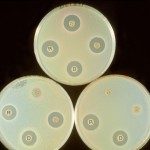Link to Pubmed [PMID] – 20110294
Microbiology (Reading, Engl.) 2010 May;156(Pt 5):1448-58
Pseudomonas aeruginosa is a major human opportunistic pathogen, especially for patients in intensive care units or with cystic fibrosis. Multidrug resistance is a common feature of this species. In a previous study we detected the ant(4′)-IIb gene in six multiresistant clinical isolates of P. aeruginosa, and determination of the environment of the gene led to characterization of Tn6061. This 26 586 bp element, a member of the Tn3 family of transposons, carried 10 genes conferring resistance to six drug classes. The ant(4′)-IIb sequence was flanked by directly repeated copies of ISCR6 in all but one of the strains studied, consistent with ISCR6-mediated gene acquisition. Tn6061 was chromosomally located in six strains and plasmid-borne in the remaining isolate, suggesting horizontal acquisition. Duplication-insertion of IS6100, that ended Tn6061, was responsible for large chromosomal inversions. Acquisition of Tn6061 and chromosomal inversions are further examples of intricate mechanisms that contribute to the genome plasticity of P. aeruginosa.

